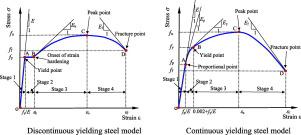Journal of Constructional Steel Research ( IF 4.1 ) Pub Date : 2021-08-07 , DOI: 10.1016/j.jcsr.2021.106879 Xing-Qiang Wang , Zhong Tao , Utsab Katwal , Chao Hou

|
In recent years, high strength steels (HSSs) with a minimum nominal yield stress of 460 MPa have been increasingly used in structural applications. An HSS may exhibit continuous or discontinuous yielding, depending on the chemical composition and manufacturing process and procedure. However, no criterion has been proposed in the literature to predict the occurrence of a yield plateau. Meanwhile, the ductility of HSSs is often limited, making it essential to predict their fracture for a safe design. However, existing stress-strain models used for HSSs cannot meet this need. To develop versatile stress-strain models for HSSs, 212 test curves are collected from open literature. In addition, four curves are obtained from tensile tests of two types of HSS produced in Australia (Bisalloy 80 and 400). By analysing the collected test data, a criterion is proposed to determine the occurrence of the yield plateau according to the yield stress of the steel and its carbon content. Two stress-strain models are then proposed for HSSs exhibiting continuous and discontinuous yielding, respectively. Moreover, predictions from the discontinuous model are also compared with the test data of conventional mild steel, proving that the model can also capture the stress-strain response of the conventional mild steel. Finally, the proposed models are used in the simulation of HSS coupons and beams, which proves the feasibility of the proposed HSS models for structural analysis.
中文翻译:

高强度钢的拉伸应力-应变模型
近年来,最小公称屈服应力为 460 MPa 的高强度钢 (HSS) 越来越多地用于结构应用。HSS 可能表现出连续或不连续屈服,这取决于化学成分和制造过程和程序。然而,文献中没有提出任何标准来预测屈服平台的出现。同时,HSS 的延展性通常是有限的,因此为了安全设计预测其断裂至关重要。然而,现有的用于 HSS 的应力应变模型不能满足这种需求。为了开发适用于 HSS 的通用应力-应变模型,从公开文献中收集了 212 条测试曲线。此外,四个曲线是从澳大利亚生产的两种高速钢(Bisalloy 80 和 400)的拉伸试验中获得的。通过分析收集到的测试数据,提出了根据钢的屈服应力及其含碳量确定屈服平台发生的判据。然后分别为呈现连续和不连续屈服的高速钢提出了两种应力应变模型。此外,不连续模型的预测也与常规低碳钢的测试数据进行了比较,证明该模型也可以捕捉常规低碳钢的应力应变响应。最后,将所提出的模型用于高速钢试样和梁的仿真,证明了所提出的高速钢模型用于结构分析的可行性。分别。此外,不连续模型的预测也与常规低碳钢的测试数据进行了比较,证明该模型也可以捕捉常规低碳钢的应力应变响应。最后,将所提出的模型用于高速钢试样和梁的仿真,证明了所提出的高速钢模型用于结构分析的可行性。分别。此外,不连续模型的预测也与常规低碳钢的测试数据进行了比较,证明该模型也可以捕捉常规低碳钢的应力应变响应。最后,将所提出的模型用于高速钢试样和梁的仿真,证明了所提出的高速钢模型用于结构分析的可行性。


























 京公网安备 11010802027423号
京公网安备 11010802027423号